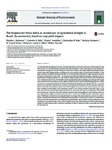Please use this identifier to cite or link to this item:
http://www.alice.cnptia.embrapa.br/alice/handle/doc/1060916| Title: | The Evaporative Stress Index as an indicator of agricultural drought in Brazil: An assessment based on crop yield impacts. |
| Authors: | ANDERSON, M. C.  ZOLIN, C. A.   SENTELHAS, P. C.   HAIN, C. R.   SEMMENS, K.   YILMAZ, M. T.   FENG GAO   OTKIN, J. A.   TETRAULT, R.   |
| Affiliation: | MARTHA C. ANDERSON, USDA-ARS; CORNELIO ALBERTO ZOLIN, CPAMT; PAULO C. SENTELHAS, USP-ESALQ; CHRISTOPHER R. HAIN, University of Maryland; KATHRYN SEMMENS, NURTURE NATURE CENTER; M. TUGRUL YILMAZ, ANKARA; FENG GAO, USDA-ARS; JASON A. OTKIN, UNIVERSITY OFWISCONSIN-MADISON; ROBERT TETRAULT, USDA. |
| Date Issued: | 2016 |
| Citation: | Remote Sensing of Environment, v. 174, p. 82-99, mar. 2016. |
| Description: | To effectivelymeet growing food demands, the global agronomic communitywill require a better understanding of factors that are currently limiting crop yields and where production can be viably expanded with minimal environmental consequences. Remote sensing can inform these analyses, providing valuable spatiotemporal information about yield-limiting moisture conditions and crop response under current climate conditions. In this paper we study correlations for the period 2003?2013 between yield estimates for major crops grown in Brazil and the Evaporative Stress Index (ESI) ? an indicator of agricultural drought that describes anomalies in the actual/ reference evapotranspiration (ET) ratio, retrieved using remotely sensed inputs of land surface temperature (LST) and leaf area index (LAI). The strength and timing of peak ESI-yield correlations are comparedwith results using remotely sensed anomalies in water supply (rainfall from the Tropical Rainfall Mapping Mission; TRMM) and biomass accumulation (LAI from the Moderate Resolution Imaging Spectroradiometer; MODIS). Correlation patternswere generally similar between all indices, both spatially and temporally,with the strongest correlations found in the south and northeast where severe flash droughts have occurred over the past decade, and where yield variability was the highest. Peak correlations tended to occur during sensitive crop growth stages. At the state scale, the ESI provided higher yield correlations for most crops and regions in comparison with TRMM and LAI anomalies. Using finer scale yield estimates reported at the municipality level, ESI correlations with soybean yields peaked higher and earlier by 10 to 25 days in comparison to TRMM and LAI, respectively. In most states, TRMMpeak correlationsweremarginally higher on average with municipality-level annual corn yield estimates, although these estimates do not distinguish between primary and late season harvests. A notable exception occurred in the northeastern state of Bahia,where the ESI better captured effects of rapid cycling of moisture conditions on corn yields during a series of flash drought events. The results demonstrate that formonitoring agricultural drought in Brazil, value is added by combining LAI with LST indicatorswithin a physically basedmodel of crop water use. |
| NAL Thesaurus: | Water stress |
| Keywords: | Evaporative Stress |
| DOI: | http://dx.doi.org/10.1016/j.rse.2015.11.034 |
| Type of Material: | Artigo de periódico |
| Access: | openAccess |
| Appears in Collections: | Artigo em periódico indexado (CPAMT)  |
Files in This Item:
| File | Description | Size | Format | |
|---|---|---|---|---|
| 2016cpamtzolinevaporativestressindicatoragriculturaldroughtbrazil.pdf | 4.95 MB | Adobe PDF |  View/Open |









